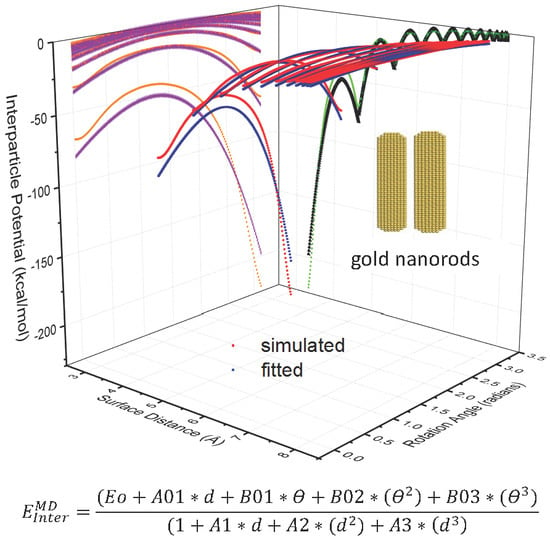A New Interaction Force Model of Gold Nanorods Derived by Molecular Dynamics Simulation
Abstract
:1. Introduction
2. Simulation Methods and Conditions
3. Results and Discussions
3.1. Models and Dynamic Collision of AuNRs
3.2. Interparticle Potentials of AuNRs with Different Aspect Ratios
3.3. Interparticle Potential and Force Models of AuNRs with Different Aspect Ratios
3.4. Interparticle Interactions of AuNRs with Different Configurations
4. Conclusions
Author Contributions
Funding
Acknowledgments
Conflicts of Interest
References
- Liu, J.; Shih, W.Y.; Sarikaya, M.; Aksay, I.A. Fractal colloidal aggregates with finite interparticle interactions: Energy dependence of the fractal dimension. Phys. Rev. A 1990, 41, 3206. [Google Scholar] [CrossRef] [PubMed]
- Fiorani, D.; Testa, A.M.; Lucari, F.; D’orazio, F.; Romero, H. Magnetic properties of maghemite nanoparticle systems: Surface anisotropy and interparticle interaction effects. Phys. B Condens. Matter 2002, 320, 122–126. [Google Scholar] [CrossRef]
- Jiang, X.C.; Zeng, Q.H.; Chen, C.Y.; Yu, A.B. Self-assembly of particles: Some thoughts and comments. J. Mater. Chem. 2011, 21, 16797–16805. [Google Scholar] [CrossRef]
- Batchelor, G. The effect of Brownian motion on the bulk stress in a suspension of spherical particles. J. Fluid Mech. 1977, 83, 97–117. [Google Scholar] [CrossRef]
- Zhang, Y.; Cai, P.; Jiang, F.; Dong, K.; Jiang, Y.; Wang, B. Understanding the separation of particles in a hydrocyclone by force analysis. Powder Technol. 2017, 322, 471–489. [Google Scholar] [CrossRef]
- Zhang, L.; Cecil, J.; Vasquez, D.; Jones, J.; Garner, B. Modeling of van der Waals forces during the assembly of micro devices. In Proceedings of the 2006 IEEE International Conference on Automation Science and Engineering, Shanghai, China, 8–10 October 2006. [Google Scholar]
- Yao, W.; Guangsheng, G.; Fei, W.; Jun, W. Fluidization and agglomerate structure of SiO2 nanoparticles. Powder Technol. 2002, 124, 152–159. [Google Scholar] [CrossRef]
- Rahman, M.; Zhu, H.; Yu, A.; Bridgwater, J. DEM simulation of particle percolation in a packed bed. Particuology 2008, 6, 475–482. [Google Scholar] [CrossRef]
- Sajanlal, P.R.; Sreeprasad, T.S.; Samal, A.K.; Pradeep, T. Anisotropic nanomaterials: Structure, growth, assembly, and functions. Nano Rev. 2011, 2, 5883. [Google Scholar] [CrossRef]
- Inshakov, O.; Inshakova, E. World market for nanomaterials: Structure and trends. In Proceedings of the MATEC Web of Conferences, Warsaw, Poland, 21–25 August 2017. [Google Scholar]
- Honeycutt, J.D.; Andersen, H.C. Molecular dynamics study of melting and freezing of small Lennard-Jones clusters. J. Phys. Chem. 1987, 91, 4950–4963. [Google Scholar] [CrossRef]
- White, D.N. A computationally efficient alternative to the Buckingham potential for molecular mechanics calculations. J. Comput.-Aided Mol. Des. 1997, 11, 517–521. [Google Scholar] [CrossRef] [PubMed]
- Chen, X.; Levi, A.; Tosatti, E. Hamaker constant calculations and surface melting of metals. Surf. Sci. 1991, 251, 641–644. [Google Scholar] [CrossRef]
- Rentsch, S.; Pericet-Camara, R.; Papastavrou, G.; Borkovec, M. Probing the validity of the Derjaguin approximation for heterogeneous colloidal particles. Phys. Chem. Chem. Phys. 2006, 8, 2531–2538. [Google Scholar] [CrossRef] [Green Version]
- Zeng, Q.; Yu, A.; Lu, G. Evaluation of interaction forces between nanoparticles by molecular dynamics simulation. Ind. Eng. Chem. Res. 2010, 49, 12793–12797. [Google Scholar] [CrossRef]
- Sun, W.; Zeng, Q.; Yu, A. Calculation of noncontact forces between silica nanospheres. Langmuir 2013, 29, 2175–2184. [Google Scholar] [CrossRef]
- Su, B.; Rajkumar, K.; Agrawal, M. Limitation of CD AFM on resist foot detection. In Metrology, Inspection, and Process Control for Microlithography XII; International Society for Optics and Photonics: Bellingham, WI, USA, 1998. [Google Scholar]
- Sun, W.; Zeng, Q.; Yu, A. Interaction forces between carbon nanospheres: A molecular dynamics simulation study. Chem. Eng. Sci. 2015, 121, 23–31. [Google Scholar] [CrossRef]
- Wang, W.; Donini, O.; Reyes, C.M.; Kollman, P.A. Biomolecular simulations: Recent developments in force fields, simulations of enzyme catalysis, protein-ligand, protein-protein, and protein-nucleic acid noncovalent interactions. Annu. Rev. Biophys. Biomol. Struct. 2001, 30, 211–243. [Google Scholar] [CrossRef] [Green Version]
- Zhu, H.P.; Zhou, Z.Y.; Yang, R.Y.; Yu, A.B. Discrete particle simulation of particulate systems: A review of major applications and findings. Chem. Eng. Sci. 2008, 63, 5728–5770. [Google Scholar] [CrossRef]
- Poulikakos, D.; Arcidiacono, S.; Maruyama, S. Molecular dynamics simulation in nanoscale heat transfer: A review. Microscale Thermophys. Eng. 2003, 7, 181–206. [Google Scholar] [CrossRef]
- Dong, Y.; Li, Q.; Martini, A. Molecular dynamics simulation of atomic friction: A review and guide. J. Vac. Sci. Technol. A Vac. Surf. Film. 2013, 31, 030801. [Google Scholar] [CrossRef] [Green Version]
- Sun, W.; Zeng, Q.; Yu, A.B. One approximate generic equation for calculating inter-nanoparticle forces. Powder Technol. 2017, 314, 2–8. [Google Scholar] [CrossRef]
- Sun, W.F.; Zeng, Q.H.; Yu, A.B. Computational studies on interparticle forces between nanoellipsoids. RSC Adv. 2014, 4, 38505–38516. [Google Scholar] [CrossRef]
- Sun, W.; Li, Y.; Xu, W.; Mai, Y.W. Interactions between crystalline nanospheres: Comparisons between molecular dynamics simulations and continuum models. RSC Adv. 2014, 4, 34500–34509. [Google Scholar] [CrossRef]
- Sun, W.; Li, Y.; Xu, W.; Mai, Y.W. Calculation of Normal Contact Forces between Silica Nanospheres. Langmuir 2013, 29, 7825–7837. [Google Scholar] [CrossRef] [PubMed]
- Yang, P.; Zeng, Q.; Dong, K.; Zhu, H. A quick method for developing interparticle force models of spherical gold nanoparticles from molecular dynamics simulation. Powder Technol. 2020, 362, 501–506. [Google Scholar] [CrossRef]
- Ghosh, P.; Han, G.; De, M.; Kim, C.K.; Rotello, V.M. Gold nanoparticles in delivery applications. Adv. Drug Deliv. Rev. 2008, 60, 1307–1315. [Google Scholar] [CrossRef]
- Sperling, R.A.; Gil, P.R.; Zhang, F.; Zanella, M.; Parak, W.J. Biological applications of gold nanoparticles. Chem. Soc. Rev. 2008, 37, 1896–1908. [Google Scholar] [CrossRef]
- Dykman, L.; Khlebtsov, N. Gold nanoparticles in biomedical applications: Recent advances and perspectives. Chem. Soc. Rev. 2012, 41, 2256–2282. [Google Scholar] [CrossRef] [PubMed]
- Pissuwan, D.; Valenzuela, S.M.; Cortie, M.B. Prospects for gold nanorod particles in diagnostic and therapeutic applications. Biotechnol. Genet. Eng. Rev. 2008, 25, 93–112. [Google Scholar] [CrossRef] [Green Version]
- Xu, L.; Kuang, H.; Wang, L.; Xu, C. Gold nanorod ensembles as artificial molecules for applications in sensors. J. Mater. Chem. 2011, 21, 16759–16782. [Google Scholar] [CrossRef]
- Niidome, T.; Yamagata, M.; Okamoto, Y.; Akiyama, Y.; Takahashi, H.; Kawano, T.; Katayama, Y.; Niidome, Y. PEG-modified gold nanorods with a stealth character for in vivo applications. J. Control. Release 2006, 114, 343–347. [Google Scholar] [CrossRef]
- Meunier, M. Introduction to materials studio. In Proceedings of the EPJ Web of Conferences, Dubna, Russia, 2–7 July 2012. [Google Scholar]
- Sun, H.; Jin, Z.; Yang, C.; Akkermans, R.L.; Robertson, S.H.; Spenley, N.A.; Miller, S.; Todd, S.M. COMPASS II: Extended coverage for polymer and drug-like molecule databases. J. Mol. Modeling 2016, 22, 47. [Google Scholar] [CrossRef] [PubMed]
- Battista, A.; Rosa, L.; dell’Erba, R.; Greco, L. Numerical investigation of a particle system compared with first and second gradient continua: Deformation and fracture phenomena. Math. Mech. Solids 2017, 22, 2120–2134. [Google Scholar] [CrossRef] [Green Version]
- Della Corte, A.; Battista, A.; Dell’Isola, F.; Giorgio, I. Modeling deformable bodies using discrete systems with centroid-based propagating interaction: Fracture and crack evolution. In Mathematical Modelling in Solid Mechanics; Springer: Berlin/Heidelberg, Germany, 2017; pp. 59–88. [Google Scholar]
- AminPour, H.; Rizzi, N. A one-dimensional continuum with microstructure for single-wall carbon nanotubes bifurcation analysis. Math. Mech. Solids 2016, 21, 168–181. [Google Scholar] [CrossRef]
- Gay, J.; Berne, B. Modification of the overlap potential to mimic a linear site–site potential. J. Chem. Phys. 1981, 74, 3316–3319. [Google Scholar] [CrossRef]
- Persson, R.A. Note: Modification of the Gay-Berne potential for improved accuracy and speed. J. Chem. Phys. 2012, 136, 226101. [Google Scholar] [CrossRef] [Green Version]
- Berardi, R.; Fava, C.; Zannoni, C. A Gay–Berne potential for dissimilar biaxial particles. Chem. Phys. Lett. 1998, 297, 8–14. [Google Scholar] [CrossRef]
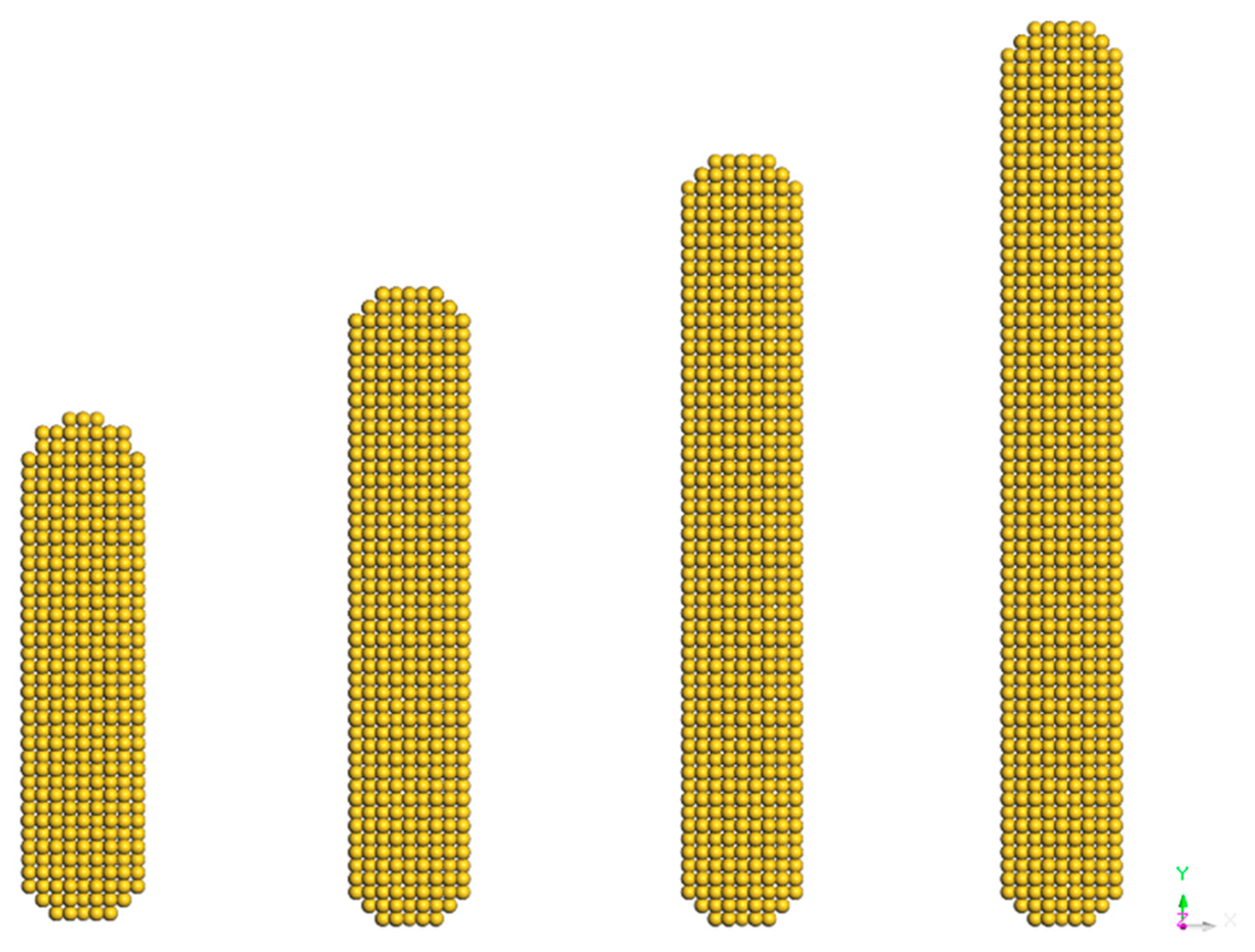
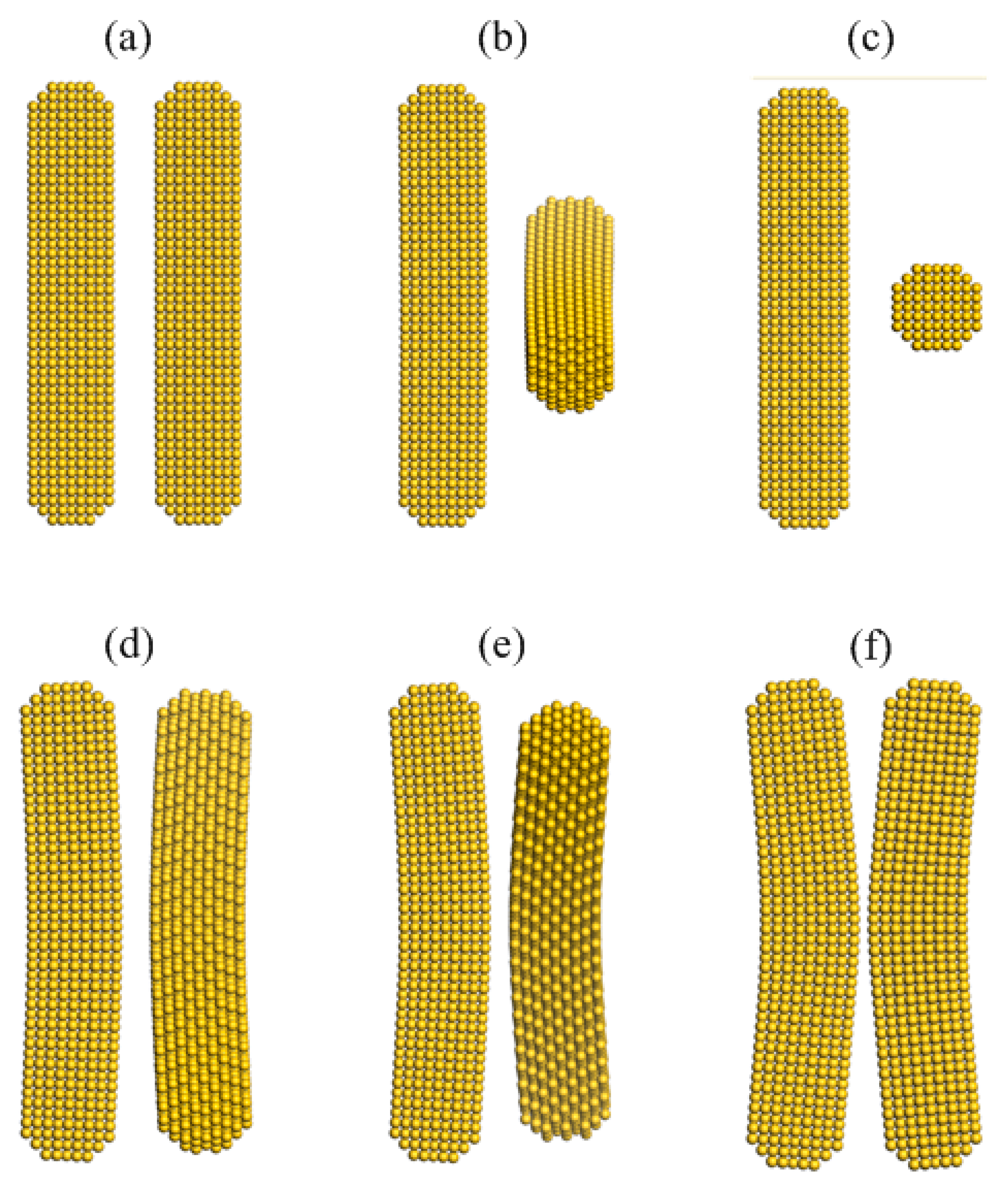
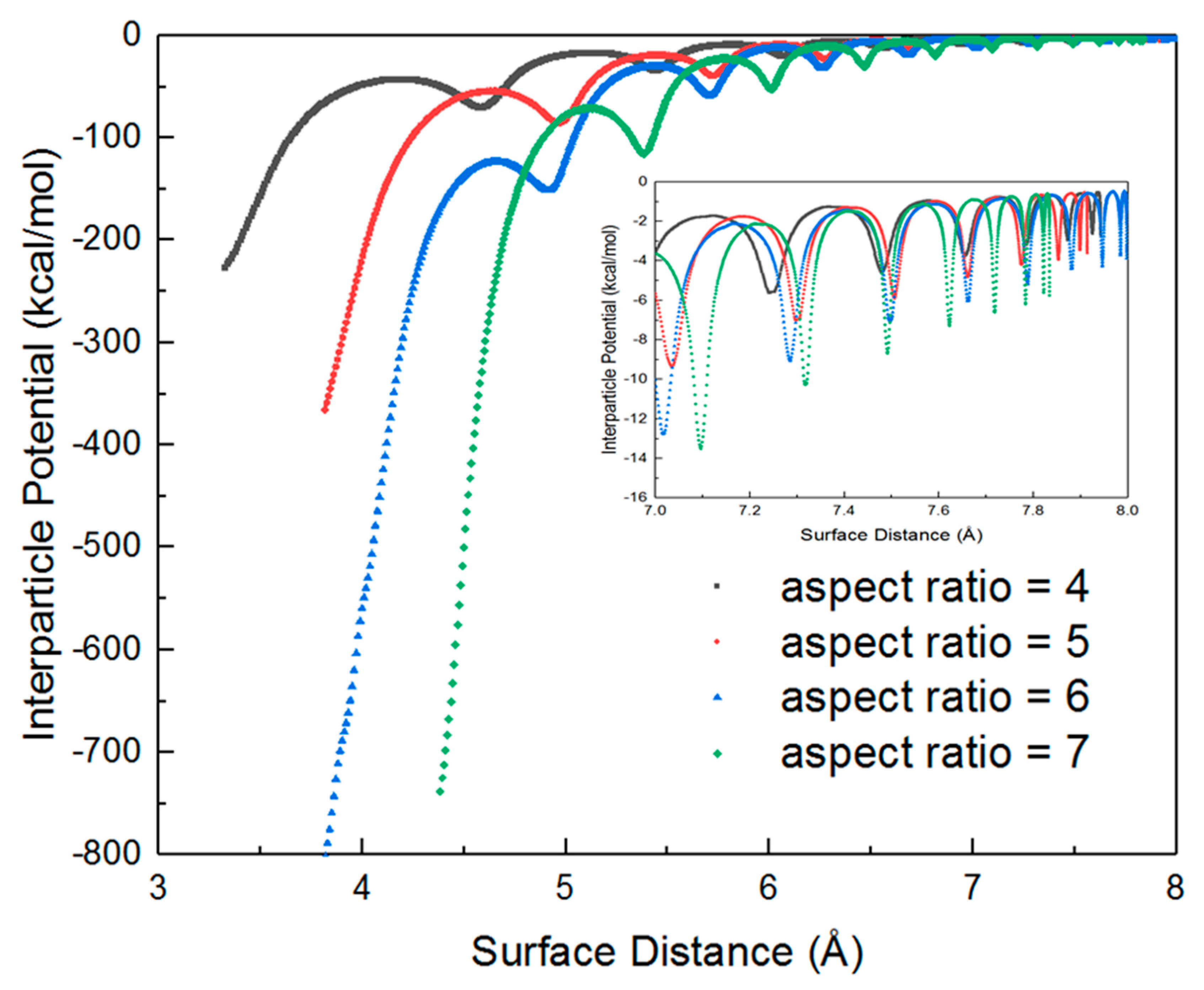
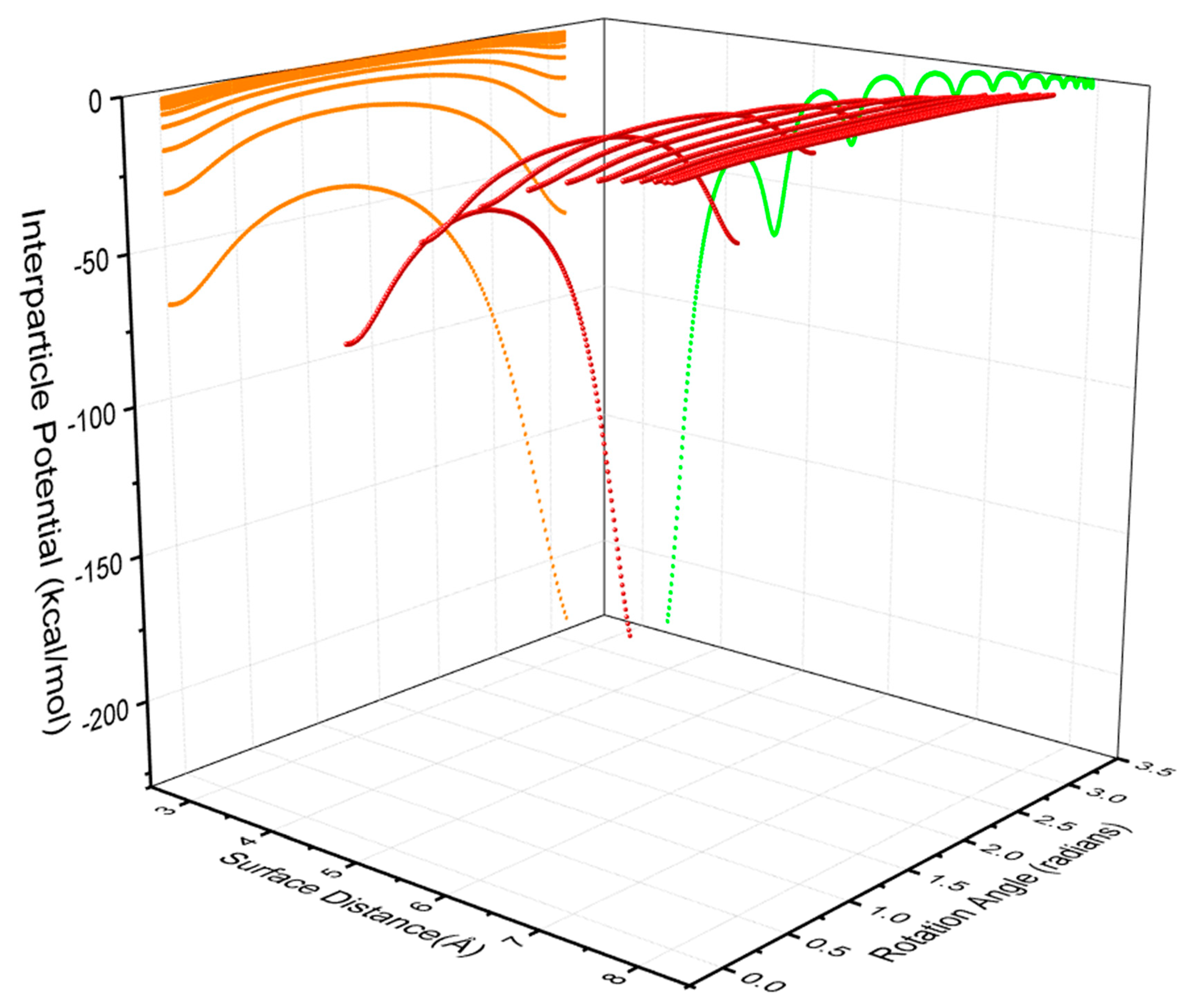
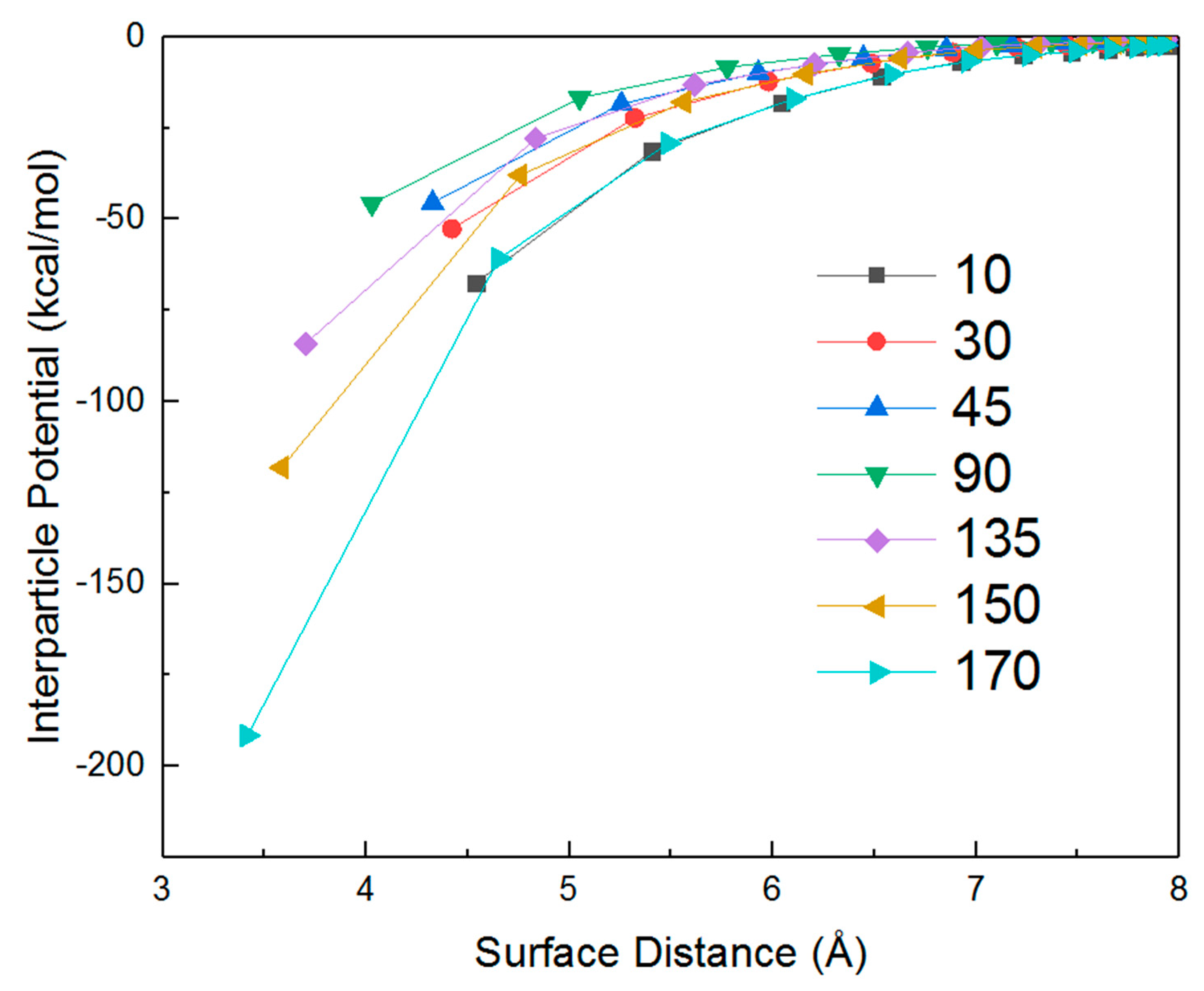
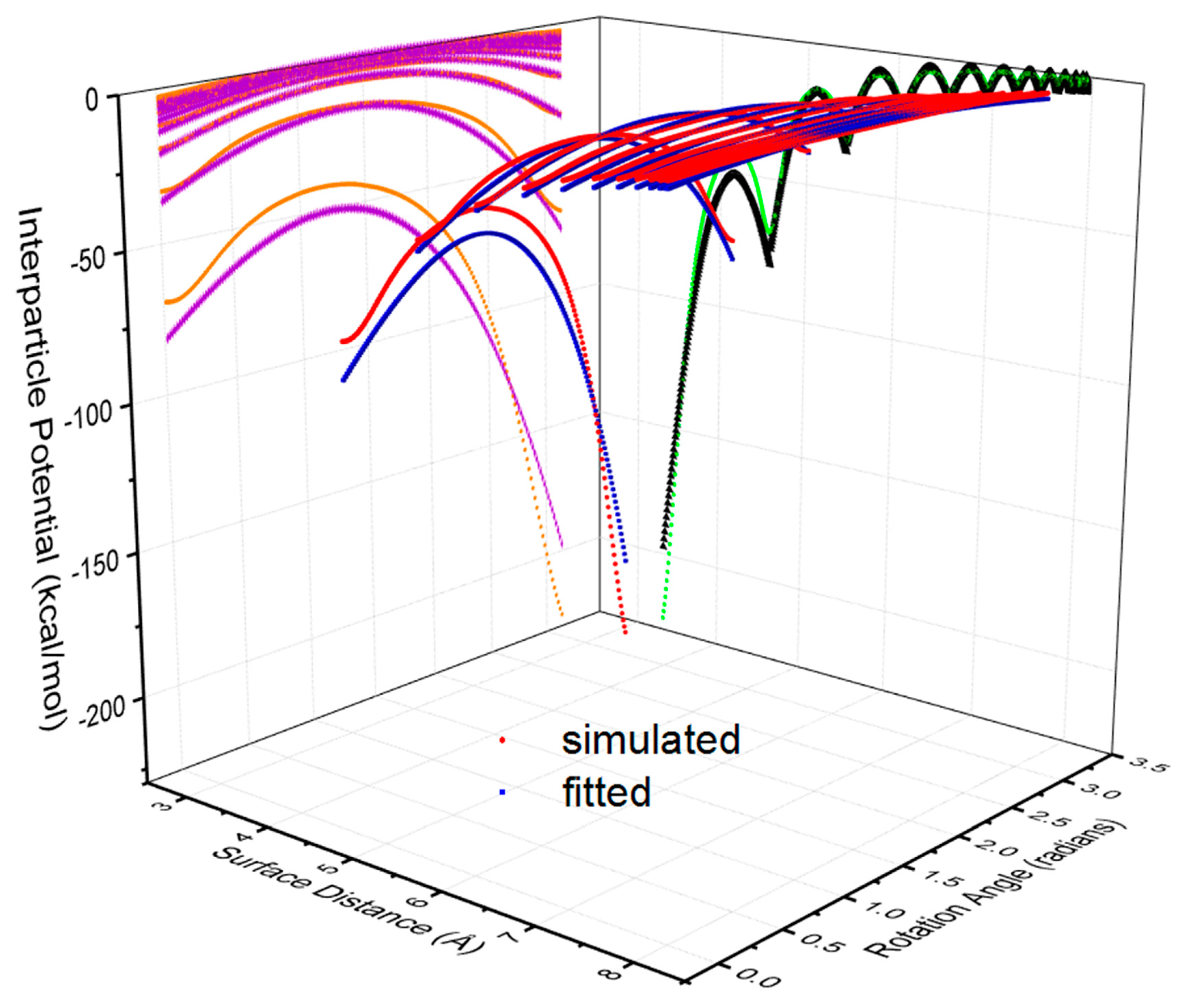
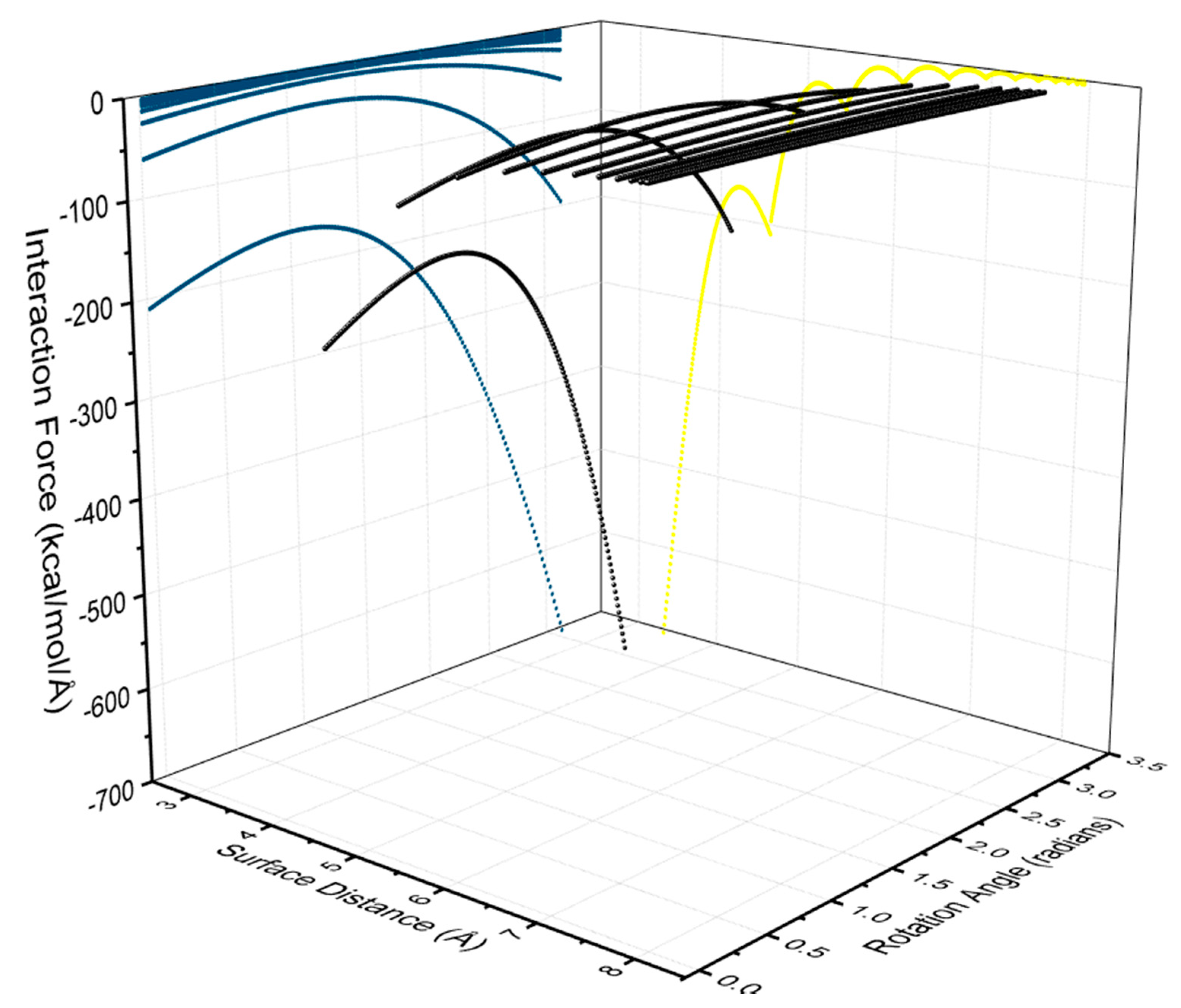
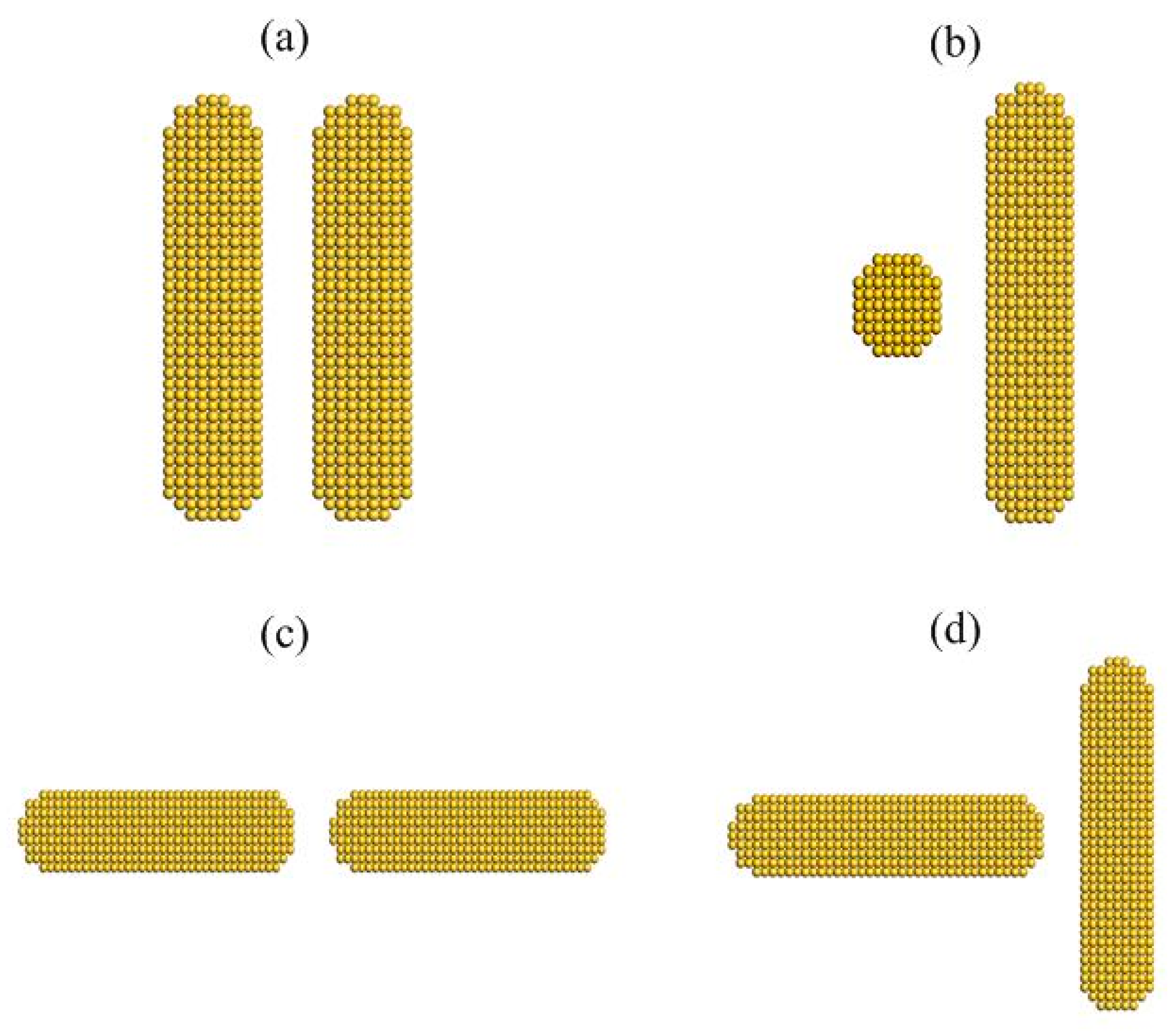
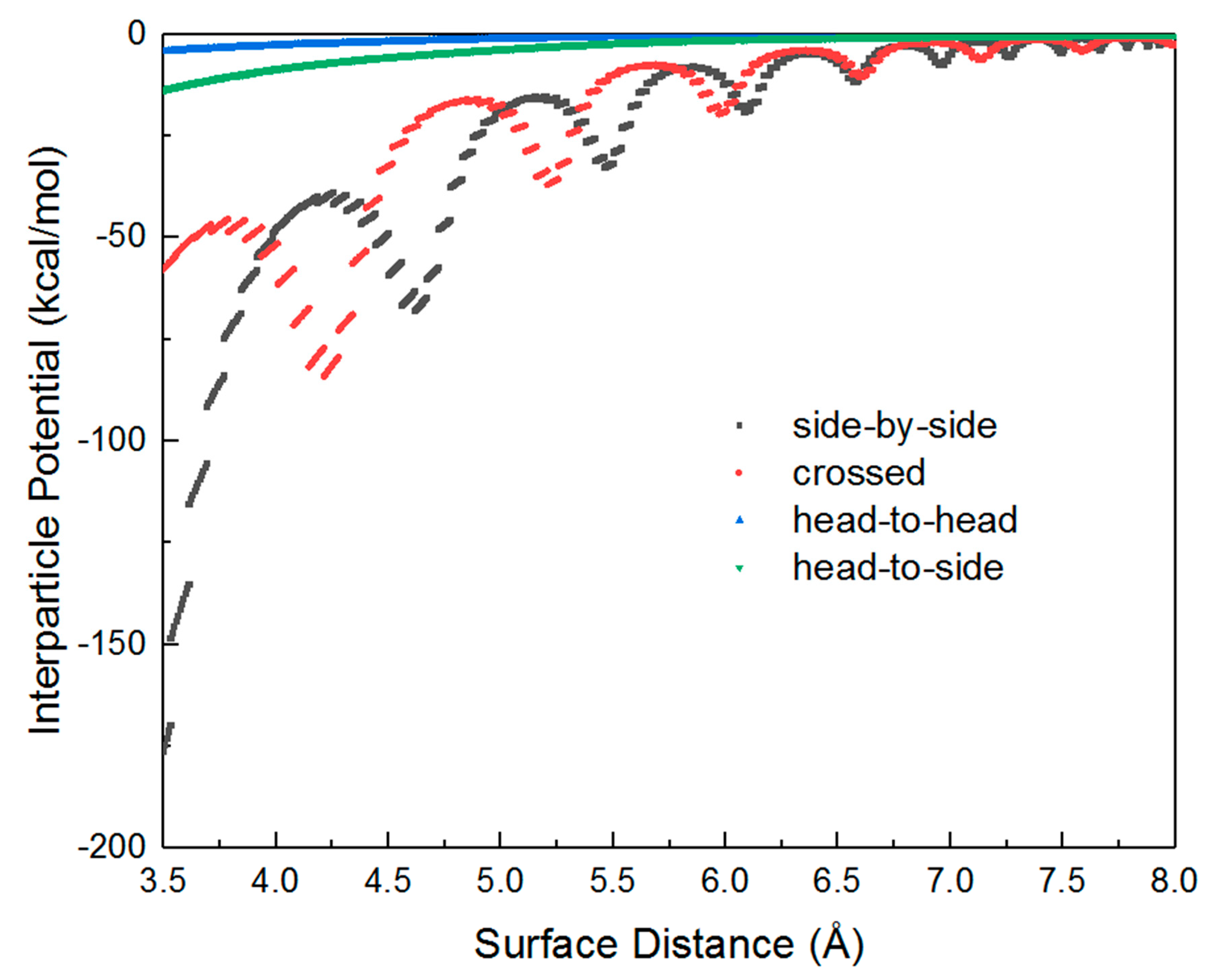
| Aspect Ratio (L/D) | 4 | 5 | 6 | 7 |
|---|---|---|---|---|
| Eo | 195.10 | 1157.96 | 13476.12 | 23103.31 |
| A01 | −13.85 | −90.06 | −1314.02 | −2192.18 |
| B01 | −110.73 | −602.08 | −8091.66 | −8719.83 |
| B02 | 38.79 | 211.73 | 4505.65 | 2012.23 |
| B03 | −1.47 | −8.49 | −657.60 | 310.59 |
| A1 | −1.90 | −8.74 | −37.60 | 6.91 |
| A2 | 0.75 | 4.07 | 20.67 | 12.74 |
| A3 | −0.10 | −0.54 | −2.99 | −3.26 |
| R2 | 0.99 | 0.99 | 0.99 | 0.99 |
© 2020 by the authors. Licensee MDPI, Basel, Switzerland. This article is an open access article distributed under the terms and conditions of the Creative Commons Attribution (CC BY) license (http://creativecommons.org/licenses/by/4.0/).
Share and Cite
Yang, P.; Zeng, Q.; Dong, K.; Zhu, H.; Yu, A. A New Interaction Force Model of Gold Nanorods Derived by Molecular Dynamics Simulation. Nanomaterials 2020, 10, 1293. https://doi.org/10.3390/nano10071293
Yang P, Zeng Q, Dong K, Zhu H, Yu A. A New Interaction Force Model of Gold Nanorods Derived by Molecular Dynamics Simulation. Nanomaterials. 2020; 10(7):1293. https://doi.org/10.3390/nano10071293
Chicago/Turabian StyleYang, Pan, Qinghua Zeng, Kejun Dong, Haiping Zhu, and Aibing Yu. 2020. "A New Interaction Force Model of Gold Nanorods Derived by Molecular Dynamics Simulation" Nanomaterials 10, no. 7: 1293. https://doi.org/10.3390/nano10071293
APA StyleYang, P., Zeng, Q., Dong, K., Zhu, H., & Yu, A. (2020). A New Interaction Force Model of Gold Nanorods Derived by Molecular Dynamics Simulation. Nanomaterials, 10(7), 1293. https://doi.org/10.3390/nano10071293







